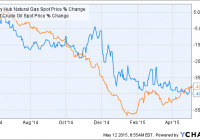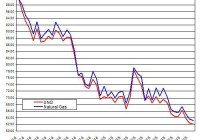What Happened To Natural Gas ETFs In October?
This year has been bad for commodities, and natural gas is no exception. China-led global economic slowdown, supply glut and stronger dollar ahead of an impending Fed rate hike have been battering the performance of the energy sector. However, October was a balanced month for natural gas as it faced both the odds and advantages. Natural gas kicked off the month with an amazing performance. There were a number of factors that led to the bullish trend in their prices despite oversupply concerns. After hitting its three-year low, natural gas prices began to rise due to short covering and bottom fishing by traders. This was complemented by rebounding optimism in crude oil as many oil producing companies are also engaged in the production of natural gas. Oil price crossed its $50 per barrel mark on October 8 for the first time since July. The rally extended when consensus of a chilly winter across the eastern parts of the U.S. began to build up. Cold weather boosts demand for natural gas, which is used by around 50% of the U.S. households as the main source of heating fuel. November through March is generally considered as a peak season for natural gas when heating demand is at a high. This led natural gas futures for November contract to settle at the highest level of $2.535 per MMBtu (million British thermal units) on October 12 since September 29. However, natural gas prices retreated in the second half of October when forecast of a warmer-than-normal winter in the U.S., partly due to the El Niño phenomenon, became pronounced for the coming weeks. In the last week of the month, MDA Weather Services had predicted that heating degree days (measurement reflecting the demand for energy required to heat a building) will be 178 over the next two weeks in contrast to 199 in the same period last year. The lower heating degree days indicates warmer weather in the lower 48 states of the U.S.. The forecast of a mild weather pushed natural gas prices to its three-year low of $1.948 per MMBtu on October 27, their lowest since April 2012. This intensified concerns of a supply glut as a mild winter means lower demand for natural gas. However, the supply situation didn’t turn to be as bad as expected when the U.S. Energy Information Administration (“EIA”) released its October 29 update on natural gas inventories for the week ended October 23. The EIA report revealed a less-than-expected rise in natural gas inventories in storage, which increased 63 Bcf (billion cubic feet) to 3,877 Bcf compared to the expected rise of 69 Bcf. This led to some respite in the natural gas market as its price surged 11% from the previous day to $2.257 per MMBtu on October 29. However, concerns about a mild winter loomed yet again, beginning to dampen prices at the start of November. ETFs that follow the natural gas futures witnessed the same swings during October. Below we highlight three of them that were strongly influenced by the topsy-turvy movements of the natural gas futures during the month. United States Natural Gas Fund (NYSEARCA: UNG ) UNG tracks the movements of the price of natural gas as delivered at the Henry Hub, Louisiana. The ETF has been able to manage $487 million in its asset base and is actively traded with about 5.6 million shares per day. It charges 60 bps in annual fees and expenses. The product gained 1.3% in the first half of October but retreated 13.3% in the second half of the month. United States 12 Month Natural Gas Fund (NYSEARCA: UNL ) This fund is designed to track, in percentage terms, the movements of natural gas prices. It has garnered nearly $13 million in assets and trades in an average volume of 23,000 shares a day. It charges 75 bps in investor fees and returned 2.3% in the first half of October but lost 8.8% in the latter half of the month. iPath Dow Jones-UBS Natural Gas Subindex Total Return ETN (NYSEARCA: GAZ ) GAZ follows the Dow Jones-UBS Natural Gas Subindex Total Return Index, measuring the returns that are available through an investment in the futures contracts of the Henry Hub Natural Gas futures traded on the NYMEX as well as the rate of interest from an investment in U.S. Treasury Bills. The note is quite overlooked as it has amassed just about $7 million in its asset base while it sees average volume of roughly 27,000 shares a day. It has an expense ratio of 0.75% and returned 4.5% in the October first half but retreated as much as 25% in the latter. Original Post

